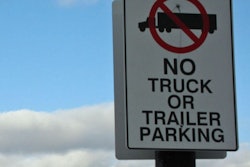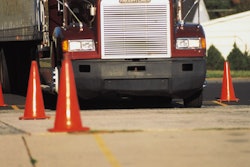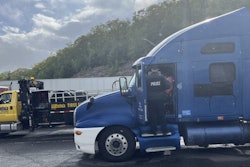Learn the easy steps to backing safely.
Truck drivers hear the three simple rules of backing up over and over again, like mama scolding: “When backing in, go slow, get out and look (GOAL), and most of all, don’t hit anything.”
Yeah, you’ve heard it before. But backing remains the most accident-prone part of the job, and almost all backing mishaps occur because drivers ignore the rules, get in a hurry, don’t get out and look, and hit something. Inexperienced drivers don’t know any better. Old-timers sometime think they know better and stop thinking.
Usually, a driver is least likely to slow down and get out to look when doing so is necessary: it’s dark, cold, rainy and muddy at the end of a long, tiring day, and other drivers are on the CB giving criticism: “Do you want one of us to come and back that truck in for you?” or “Get under it, get under it,” when the self-appointed coach can’t see how little clearance you have in front.
The more unpleasant the task, the more professionalism must be applied.
Accident-free million-milers are commended for their professionalism because they give what the job requires, not what they think it should get. They back in slowly: maybe just a few inches at a time. They know what’s behind their trailers and what they’re backing into. They don’t hit anything.

The first step to backing in is not backing in. “If you can avoid backing in, do it,” says owner-operator John Brown of Hereford, Ariz. If you find a pull-through – two empty parking spots head-to-head – take it.
Don’t force the issue. If backing into one spot looks too difficult, find another. “Eight of 10 times I come to this truckstop, the place is busy, but there’s one spot that’s always open,” says owner-operator Gary Eastman from Blaine, Minn. “They can’t get into it because they don’t know how to set up for it right.”
Eastman means a spot next to last in a long row of parking places. There’s very little room to its left, so the driver who gets into it will either blind side from the right or very skillfully back in from the left.
This might be a question of experience. Newer drivers who haven’t become confident of their backing skills yet might wisely pass on a spot that a more experienced driver would try. Rookie drivers who know their limitations show unusually advanced skill and professionalism when they avoid difficult backing situations, especially compared with beginners who take on difficult back-ups, hit something and lose a safety bonus.
“I remember the first time I backed in,” says owner-operator Dustin Cullison of East Brookfield, Mass. “I was terrified, and my friends were laughing at me.” That was more than 11 years ago, but his fear stood Cullison well. “I’ve never backed into anything,” he says.
Some new drivers seem born to back up big trucks and catch on quickly. Others have previous experience maneuvering large vehicles into specific positions.
“Sometimes I have to pull up: every now and then,” says Hitchcock company driver Dave Brzak of Webberville, Mich. “But I come from a farm, and I’ve backed up equipment before. So backing in one of these trucks kind of comes natural to me.”
If you’re going to back in, the procedure starts well before the truck is in reverse.
As you drive past the place you’re about to back into, take a good look at it.
“You should always look as you approach where you’re going to back in, so you get a good idea of what you’re backing into,” Cullison says. Is the space wide and deep enough? Is the pavement smooth or rough? In a tight spot, if the trailer tandems fall into a pothole, the entire trailer might lurch over into another next door. With a flashlight if necessary, look for debris that might flat a tire or tools and equipment, like chocks from the last driver, left in the way. Is there room in the lot in front of the spot to get set up to park?
“The most important thing you can do when backing in is get your set up right,” Eastman says. “You put the truck where it’s going to be easiest to back in.”
Some customers invite big trucks in but don’t seem ready for them. They have curbs, fences, walls and ditches barely a truck length from the dock, and backing in seems impossible. But other drivers have done it, and so can you.
Positioning the truck correctly before backing in makes all the difference. Eastman drives a 1978 Peterbilt 379 with an extended hood. “My tractor has a 265-inch wheelbase, and I pull a 53-foot van, so some places are hard to back into,” he says. “But the Pete backs in easier than some shorter trucks because the drivers don’t set up right.”
One good setup method is to approach in a straight line with the parking spaces on your left and your truck about three feet from the row of parked vehicles. The closer your trailer tandems, the better. As you pass your empty spot, stop and check it out; then look right and find a landmark directly in front of your spot. Idle forward past one more spot.
As you do, turn your four-way flashers on and check your right-side mirrors to make sure no trucks are coming up behind you. As soon as the driver’s window reaches the second parking spot after yours, quickly turn the steering wheel all the way to the right. Stay at idle – slower on slick surfaces – so the truck’s forward momentum won’t push the steering tires into a wider arc.
If space will allow, let the truck idle hard about to the right. Find the landmark, and when your truck’s front end seems even with it, crank the wheel hard left, idle back about and go straight at the landmark until your empty spot is in both mirrors. Your back-up should be straight or nearly so.
Usually there’s not enough space to set up for a straight back in, so after you’ve checked your spot, idled past one more, cranked the wheel hard right and are coming about, your judgment comes into play. Consider weather, light, road surface, truck weight, length and maneuverability, the empty spot’s width, the amount of space you have to work in and your limitations. You’ll either take your best guess or simply know when to come hard about back left. Slow down; it’s easy to go too fast and too far at this point. As the truck comes back about left, find the empty parking spot and the trailer’s back end or left rear marker light in the driver’s mirror or from the driver’s window, and stop, keeping the trailer tandems as close to your empty spot as possible.
Now your setup is good. If not, fine-tune it by pulling forward slowly and realigning the trailer until your gut instinct says you can back it in.
Once you have the setup right, get ready to back in. If your four-way flashers aren’t on, turn them on. Give the air horn a short toot to announce your intentions. Eliminate distractions: turn off music, and turn off the CB radio.
“If I listen to the CB while I’m backing, I’ll lose my train of thought, and it will mess me up,” Cullison says.
Those coaching you over the CB might mean well, but can they even see what you’re doing? “If they’re not standing at the back of the trailer, how do you know they’re even watching? They might be driving by or sitting across the truckstop telling you, ‘come on back, come on back,’ and then crunch! And then they’ll laugh at you.”
“If they want to help you, they have to get out of the truck and come help you,” Cullison says. “Besides, a professional never takes somebody else’s word.”
As you start to back up, remember the rule: go slow, get out and look, and don’t hit anything. Keep off the throttle and work the clutch. “You have to envision the truck going into the parking spot,” Cullison says.
Take all the time you need to back in safely.
“If you lose your idea of where that truck on your blind side is, you have to get out and look,” Cullison says. “In my opinion, that’s the most important step: get out and look as many times as you have to.”
When do you have to? “If you can’t see it, get out and look,” Cullison says. “I tell people that all the time.”
For most drivers, the trailer’s right rear corner presents the most problems. It’s hidden from view, and if the tandems are set forward, the rear overhang seems like it’s jutting out into the next state. If you’re unsure of how close your right rear corner is to the left front of the truck in the spot to the right, you have to get out and look to make sure you’re not hitting anything. If it’s very close, pull up and start over. If there’s plenty of clearance, continue backing slowly in. If you become unsure, get out and look again.
Drivers sometimes over-compensate for the right rear they can’t see by cutting very closely with their trailer’s left rear, which they can see. This works, but if you cut in just an inch or two away from the right front corner of the truck on the left, you’ll have to get out and look at your clearance there, too, especially in the dark. Also, if you cut it that close and your tandems hit a pothole, the trailer might lurch into the other truck.
While backing in and focusing on the rear of the trailer, don’t be afraid to stop, get your bearings and find out what’s happening around the rest of your truck.
“Everybody in America is in a hurry, and they won’t wait until you get out of the way,” Cullison says. “You have to be constantly on the alert. You’re backing up and watching behind you, and you’ll have people who want to drive around the front or pedestrians walking on your blind side,” he says. “They’ll come around you and get in your way.”
For this reason, check all sides of your truck before pulling forward.
In packed truckstop parking lots, there’s often little clearance in front of you, either. Make sure, after you’ve got the rear of the trailer into the spot and you’re ready to get under it, straighten out and back in, that when you swing the tractor in front of the trailer, you’re not swinging right into the front end of a truck parked across the lot. Before backing in, notice if any trucks in front of you are jutting out particularly far. These will cause as much trouble as the trucks behind you, and you might have to get out and look at your truck’s right front corner to make sure it will clear.
Backing a 70-foot vehicle into a parking spot or up to a dock is not an exact science. Each place you back into will be different. But in all situations, the main rules stay the same.
“The main thing to remember is don’t hit anything,” Brzak says. To do that, slow down, and get out and look.
“Watch out for other people, too,” he says.
Be mindful of other drivers. Shut your headlights off so they don’t shine into the cabs and sleepers of the trucks in front. Don’t lay on the air horn; other drivers are sleeping. Take all the time you need to back safely, but don’t dally needlessly; other drivers are probably waiting to get by, park and relax. Back in far enough to be out of the way but not so far that drivers backing in behind you don’t have enough room. Take some time to center your truck in the parking spot so you don’t crowd drivers on either side.
“Have some courtesy,” Brzak says. “There’s not enough of that out here.”









